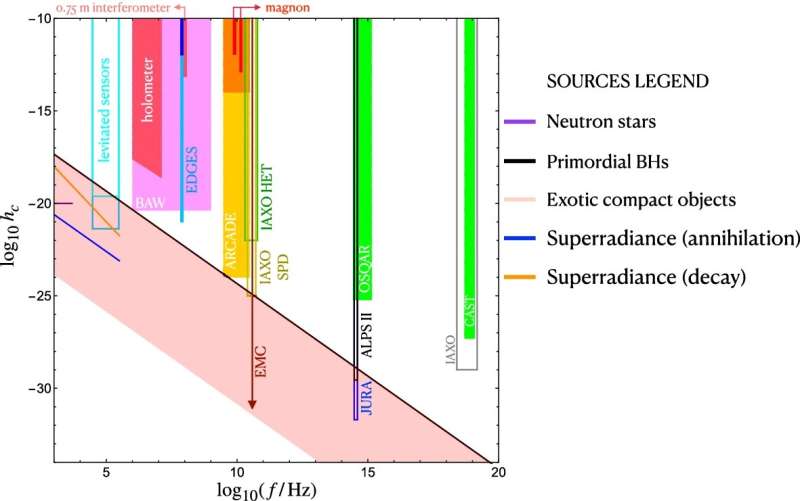Study describes challenges and opportunities for detection of high-frequency gravitational waves

Electromagnetic (EM) waves and gravitational waves are the only available means to study the Universe on a large scale. For millennia, only the former could be used, in naked-eye astronomical observations by the ancients based on the reception of visible light, or present-day super telescopes operating in various bands of the EM spectrum, from radio waves to gamma rays.
Gravitational effects can be inferred from the relative movements of celestial bodies. The first direct measurement of gravitational waves occurred only in 2015. It was effected by the Laser Interferometer Gravitational-Wave Observatory (LIGO in the United States and by the Virgo detector in Italy. As the media emphasized at the time, the feat opened up a totally new window for investigation of the Universe.
The window has so far been explored only in a relatively narrow band of frequencies ranging from 10 hertz (10 Hz) to 10 kilohertz (104 Hz). The challenges and opportunities of detecting gravitational waves at much higher frequencies, from megahertz (106 Hz) to gigahertz (109 Hz), were the focus for an in-person meeting held at Trieste, Italy, in 2019, before the pandemic.
A commentary on the workshop discussion there and a review of the literature on the topic have now been published in an article in the journal Living Reviews in Relativity.
One of the authors is Odylio Denys de Aguiar, a senior researcher at the National Space Research Institute (INPE) in Brazil.The initiative was supported by FAPESP via a Regular Research Grant and a Thematic Project for which Aguiar was principal investigator.
"To emit in the spectrum band considered, highly compact matter must oscillate at extremely high frequencies. This could happen, for example, with mini black holes, with diameters of less than a kilometer, and masses smaller than the mass of the Sun or even the mass of Earth," Aguiar said.
As noted by the researchers in the article, "there are no known astrophysical objects which are small and dense enough to emit at frequencies beyond 10 kHz. Any discovery of gravitational waves at higher frequencies would thus indicate new physics beyond the Standard Model of particle physics, linked e.g., to exotic astrophysical objects (such as primordial black holes or boson stars) or to cosmological events in the early Universe such as phase transitions, […] cosmic strings, thermal fluctuations after reheating, etc."
Any detections will confirm, correct or rule out these theoretical formulations regarding new physics.
Astronomy and cosmology were notably advanced when observations based on electromagnetic waves surpassed the visible light part of the spectrum to reach higher frequency bands. Analogously, the detection of gravitational waves at frequencies above 10 kilohertz (kHz) would open up a new window on the Universe.
"In particular, it would enable us to obtain information on the period between the Big Bang and the emission of background cosmic radiation, now captured in the form of microwaves," Aguiar said. "During that period, which lasted almost 400,000 years, electromagnetic radiation was so strongly coupled to matter that it couldn't propagate freely. Gravitational waves, however, could travel without hindrance and now form a background that might be detected."
The main obstacle is technological. "The higher the frequency, the smaller the wave's amplitude. This is because, like the EM spectrum, the gravitational-wave spectrum also follows a power law as a function of frequency with a negative exponent," Aguiar explained. "In other words, nature is more generous at low frequencies, as can be seen from the graphs on the website showing the expected amplitudes of astrophysical and cosmological sources in the Universe and the sensitivity of the main projects to detect gravitational waves with frequencies below 10 kHz."
None of the various proposals reviewed in the article would reach the required sensitivity. At most, they could achieve levels of sensitivity six orders of magnitude lower. However, the authors recall that less than 50 years ago laser interferometers were believed to have such low sensitivity that they were "of little experimental interest," according to Kip Thorne, one of the great precursors of the study of gravitational waves, with fellow-student Charles Misner, and John Archibald Wheeler, their doctoral advisor. Thorne won the 2017 Nobel Prize in Physics after the first detection of gravitation waves by the LIGO laser interferometer.
According to Aguiar, the technological solution to detect high-frequency gravitational waves will not necessarily require projects costing billions but will have to be groundbreakingly innovative.
More information: Nancy Aggarwal et al, Challenges and opportunities of gravitational-wave searches at MHz to GHz frequencies, Living Reviews in Relativity (2021). DOI: 10.1007/s41114-021-00032-5
Provided by FAPESP





















